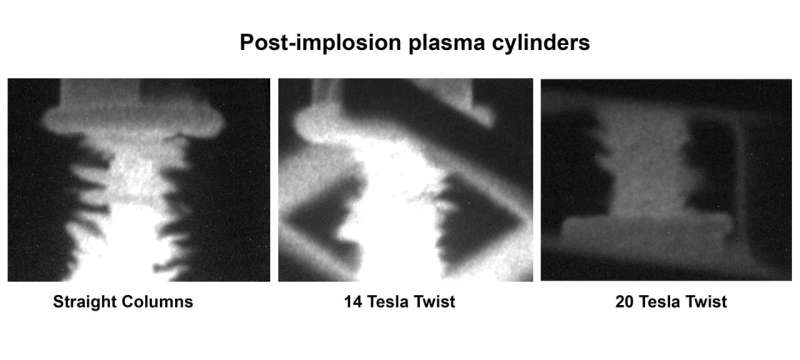Twisting magnetic fields for extreme plasma compression

A new spin on the magnetic compression of plasmas could improve materials science, nuclear fusion research, X-ray generation and laboratory astrophysics, research led by the University of Michigan suggests.
The study shows that a spring-shaped magnetic field reduces the amount of plasma that slips out between the magnetic field lines.
Known as the fourth state of matter, plasma is a gas so hot that electrons rip free of their atoms. Researchers use magnetic compression to study extreme plasma states in which the density is high enough for quantum mechanical effects to become important. Such states occur naturally inside stars and gas giant planets due to compression from gravity.
The research group led by Ryan McBride, an associate professor of nuclear engineering and radiological sciences at U-M, tests ways to achieve states like this by imploding plasma cylinders with magnetic fields. These cylinders have a tendency to break up in a "sausage link" fashion when the magnetic field finds tiny divots in the cylinder's surface and cuts into them. (The technical term is "sausage instability.")
"It's like trying to squeeze a stick of soft butter with your hands," said McBride. "The butter squishes out between your fingers."
The butter in McBride's analogy is plasma and the fingers are magnetic field lines. His group looked for a way to keep the magnetic field from digging into the imperfections in the cylinder, instead causing the field to press more uniformly on the cylinder's outer surface. They did this by twisting the magnetic field into a helix, that spring-like shape, and varying the angle at which the helix pressed on the plasma cylinder. This made it harder for the magnetic field to slice in—the field moved across many divots rather than pressing into any one divot for too long.
The most twisted magnetic configurations tested in these experiments reduced the length of the escaping plasma tentacles by about 70%. The research was done in collaboration with Sandia National Laboratories and the Laboratory of Plasma Studies at Cornell University.
The team changed the shape of the magnetic field by changing the way that the electrical current—over 1 million amperes—ran through the compression device. The electrical current typically runs up through the central cylinder that is to be compressed and then back down through straight "return current" columns that surround the central cylinder. This produces a cylindrical magnetic field that surrounds the central cylinder. To transform the cylindrical field into a helix, the team twisted the return-current columns around the central cylinder. The central cylinder starts out as a metal foil, but the huge electrical current quickly transforms the metal into a plasma. They ran the experiments on the Cornell Beam Research Accelerator.
"Designing the return current structures was an interesting balancing act," said Paul Campbell, first author on the paper and a Ph.D. student in nuclear engineering and radiological sciences at U-M. "We weren't sure we could even get these structures machined, but fortunately, metal 3-D printing has advanced far enough that we were able to get them printed instead."
Campbell explained that when the structures are more twisted, less current runs through them, so the columns had to be placed closer to the imploding plasma to compensate. At the same time, they needed gaps in the structure so that they could see what was going on with the implosion.
In line with replicating the conditions inside stars, magnetic compression is a method for compressing nuclear fusion fuel—typically variants of hydrogen—to study the processes that power stars. The technique can also generate powerful X-ray bursts and simulate astrophysical phenomena such as plasma jets near black holes.
A paper on this research, "Stabilization of liner implosions via a dynamic screw pinch," is accepted by the journal Physical Review Letters. The research will also be featured in an invited talk at the annual conference of the American Physical Society's Division of Plasma Physics in November 2020.
More information: Paul C. Campbell et al. Stabilization of liner implosions via a dynamic screw pinch. Phys. Rev. Lett. (2020)
Journal information: Physical Review Letters
Provided by University of Michigan





















